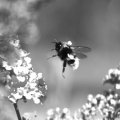A University research team has identified the bacterium responsible for a little-understood pig disease that threatens the pig industry in Vietnam and Australia.
The disease, which kills within hours, could also cause severe losses in village pig herds, an important source of wealth in Vietnam.
Identifying the bacterial strain is the first step in developing a vaccine.
The team, from the Veterinary Pathology Department, heard reports of the disease in 1994 while undertaking field work in Vietnam for the Australian Centre for International Agricultural Research (ACIAR). Previous reports were scant, and the disease had never been scientifically recognised.
A few months later, an outbreak of the disease in south-east Queensland killed 2000 pigs in a single piggery.
The University's Dr Alan Frost said the disease seemed to be related to fowl cholera in poultry and haemorrhagic septicaemia (HS) in cattle, both caused by the bacteria Pasteurella multocida.
'The bacteria is carried in the nasal pharynx of many animals, and has numerous strains ranging from harmless to virulent,' Dr Frost said.
'In cattle and buffalo, the virulent strain is serotype B2, and it was thought this strain was specific to cattle and water buffalo.
'However, our molecular biologist Dr Kirsty Townsend has shown that B2 is also present in the affected pigs.
'The question now is whether the disease passes from cattle to pigs or from pig to pig.'
Dr Frost said treatment for the disease, while possible, was impractical because animals usually died within hours of being seen to fall ill.
'We need to discover the exact nature of the disease to develop a rational design for a vaccine that will be effective and economical,' he said.
Challenges include making the vaccine cheap enough for village use, and effective against a range of virulent serotypes.
Dr Frost said the team was seeking attenuated strains of the bacteria which could protect animals against virulent strains.
He said work on the pig vaccine would also provide valuable information for improving existing vaccines against fowl cholera and HS in cattle. Understanding of the pig disease would also provide better management information, particularly for large-scale piggeries.
The researchers believe a vaccine may be developed in about a year, and are experimenting with both live and 'killed' vaccines. The former uses attenuated strains to develop resistance, while the second uses killed bacteria injected into animals to trigger an immune system response.
Further strains are being collected in Vietnam by Dr Hahn, a veterinarian in the NAVETCO research centre in Ho Chi Minh City. Dr Hahn, studying for a PhD with the University of Queensland, will analyse the samples at the University.
Others involved in the research include PhD students Denise O'Boyle, Dr Ian Wilke and Dr Hahn, and research assistant Sally Grimes.
The Australian Centre for International Agricultural Research has provided more than $1 million for the research.
For more information, contact Dr Alan Frost (Telephone 07 3365 2561).



